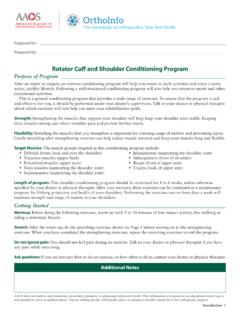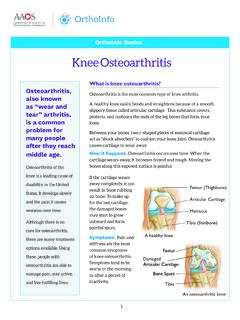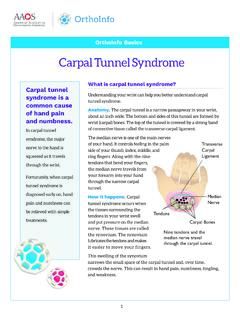Transcription of Foot and Ankle Conditioning Program - American Academy …
1 Prepared for: Prepared by:Introduction 1 AAOS does not endorse any treatments, procedures, products, or physicians referenced herein. This information is provided as an educational service and is not intended to serve as medical advice. Anyone seeking specific orthopaedic advice or assistance should consult his or her orthopaedic knowledge of orthopaedics. Your best and Ankle Conditioning ProgramPurpose of Program _____After an injury or surgery, an exercise Conditioning Program will help you return to daily activities and enjoy a more active, healthy lifestyle. Following a well-structured Conditioning Program will also help you return to sports and other recreational activities.
2 This is a general Conditioning Program that provides a wide range of exercises. To ensure that the Program is safe and effective for you, it should be performed under your doctor s supervision. Talk to your doctor or physical therapist about which exercises will best help you meet your rehabilitation : Strengthening the muscles that support your lower leg, foot, and Ankle will help keep your Ankle joint stable. Keeping these muscles strong can relieve foot and Ankle pain and prevent further : Stretching the muscles that you strengthen is important for restoring range of motion and preventing injury. Gently stretching after strengthening exercises can help reduce muscle soreness and keep your muscles long and Muscles: The muscle groups of the lower leg are targeted in this Conditioning Program , as well as the tendons and ligaments that control movement in your feet.
3 These include: Gastrocnemius-soleus complex (calf) Anterior tibialis (shin) Posterior tibialis (center of calf) Peroneus longus (outside of lower calf) Peroneus brevis (outside of lower calf) Soleus (calf) Dorsiflexors ( Ankle ) Plantar flexors ( Ankle ) Invertors ( Ankle ) Evertors ( Ankle )Length of Program : This foot and Ankle Conditioning Program should be continued for 4 to 6 weeks, unless otherwise specified by your doctor or physical therapist. After your recovery, these exercises can be continued as a maintenance Program for lifelong protection and health of your feet and lower legs. Performing the exercises three to five days a week will maintain strength and range of motion in your foot and Started _____Warm up: Before doing the following exercises, warm up with 5 to 10 minutes of low impact activity, like walking or riding a stationary : After the warm-up, do the stretching exercises shown on Page 1 before moving on to the strengthening exercises.
4 When you have completed the strengthening exercises, repeat the stretching exercises to end the not ignore pain: You should not feel pain during an exercise. Talk to your doctor or physical therapist if you have any pain while questions: If you are not sure how to do an exercise, or how often to do it, contact your doctor or physical therapist. American Academy of Orthopaedic Surgeons Exercises Page 1 AAOS does not endorse any treatments, procedures, products, or physicians referenced herein. This information is provided as an educational service and is not intended to serve as medical advice.
5 Anyone seeking specific orthopaedic advice or assistance should consult his or her orthopaedic knowledge of orthopaedics. Your best Heel Cord Stretch _____Main muscles worked: Gastrocnemius-soleus complexYou should feel this stretch in your calf and into your heelEquipment needed: NoneStep-by-step directions Stand facing a wall with your unaffected leg forward with a slight bend at the knee. Your affected leg is straight and behind you, with the heel flat and the toes pointed in slightly. Keep both heels flat on the floor and press your hips forward toward the wall. Hold this stretch for 30 seconds and then relax for 30 seconds. and Ankle Conditioning ProgramSTRETCHING EXERCISESR epetitions2 sets of 10 Days per week6 to 7 TipDo not arch your Heel Cord Stretch with Bent Knee _____Main muscles worked: SoleusYou should feel this stretch in your calf, the sides of your Ankle , and into your heelEquipment needed: NoneStep-by-step directions Stand facing a wall with your unaffected leg forward with a slight bend at the knee.
6 Your affected leg is behind you, with the knee bent and the toes pointed in slightly. Keep both heels flat on the floor and press your hips forward toward the wall. Hold the stretch for 30 seconds and then relax for 30 seconds. sets of 10 Days per week6 to 7 TipKeep your hips centered over both feet. American Academy of Orthopaedic Surgeons Exercises Page 2 AAOS does not endorse any treatments, procedures, products, or physicians referenced herein. This information is provided as an educational service and is not intended to serve as medical advice. Anyone seeking specific orthopaedic advice or assistance should consult his or her orthopaedic knowledge of orthopaedics.
7 Your best and Ankle Conditioning ProgramSTRETCHING EXERCISES3. Golf Ball Roll _____Main muscles worked: Plantar fascia ligamentYou should feel this exercise along the bottom of your footEquipment needed: Golf ballStep-by-step directions Sit on a stable chair with both feet planted on the floor. Roll a golf ball under the arch of your affected foot for 2 per weekDailyTipSit up tall and keep your foot toward your Towel Stretch _____Main muscles worked: Gastrocnemius-soleus complexYou should feel this stretch in your calf and into your heelEquipment needed: Hand towel Step-by-step directions Sit on the floor with both legs out in front of you. Loop a towel around the ball of your affected foot and grasp the ends of the towel in your hands.
8 Keep your affected leg straight and pull the towel toward you. Hold for 30 seconds and then relax for 30 seconds. Repeat 3 sets of 10 Days per week6 to 7 TipSit up tall and keep your legs straight. American Academy of Orthopaedic Surgeons Exercises Page 3 AAOS does not endorse any treatments, procedures, products, or physicians referenced herein. This information is provided as an educational service and is not intended to serve as medical advice. Anyone seeking specific orthopaedic advice or assistance should consult his or her orthopaedic knowledge of orthopaedics.
9 Your best and Ankle Conditioning ProgramSTRENGTHENING EXERCISES5. Calf Raises _____Main muscles worked: Gastrocnemius-soleus complex You should feel this exercise in your calfEquipment needed: Chair for support Step-by-step directions Stand with your weight evenly distributed over both feet. Hold onto the back of a chair or a wall for balance . Lift your unaffected foot off of the floor so that all of your weight is placed on your affected foot. Raise the heel of your affected foot as high as you can, then lower. Repeat 10 sets of 10 Days per week6 to 7 TipDo not bend the knee of your working Ankle Range of Motion _____Main muscles worked: Dorsiflexors, plantar flexors, invertors, evertors You should feel this exercise at the top of your foot and throughout your Ankle Equipment needed: NoneStep-by-step directions Sit down so that your feet do not touch the floor.
10 Use your foot to write each letter of the alphabet in the air. Lead with your big setsDays per weekDailyTipKeep the movements small, using just your foot and Ankle . American Academy of Orthopaedic Surgeons Exercises Page 4 AAOS does not endorse any treatments, procedures, products, or physicians referenced herein. This information is provided as an educational service and is not intended to serve as medical advice. Anyone seeking specific orthopaedic advice or assistance should consult his or her orthopaedic knowledge of orthopaedics. Your best Marble Pickup _____Main muscles worked: Plantar flexors You should feel this exercise at the top of your foot and toesEquipment needed: 20 marblesStep-by-step directions Sit with both feet flat and place 20 marbles on the floor in front of you.










